IND109 – Statics and Solids
Hello, dear friend, you can consult us at any time if you have any questions, add WeChat: daixieit
COURSEWORK BRIEFING
MODULE (and code): IND109 – Statics and Solids
Date set: 5th April 2024
Date of submission: 16th April 2024 (@ 11:59 pm, just before midnight)
Weight: 30% of final mark
Module Overview: IND109 Statics and Solids is designed to provide students with fundamental knowledge and practical skills in analyzing and understanding the behaviour of various structural systems. Through theoretical concepts and practical applications, students will learn to analyze simple structural systems, including beams and trusses, as well as apply relevant techniques for determining forces and reactions within these systems.
Section 1: Simple Structural Systems [40 marks]: In this section, students will analyse four different structural systems consisting with varying support reactions. For each system, students are required to:
1. Draw the Free Body Diagram (FBD) and identify the type (e.g. hinge, roller etc.) and number of support reactions in the system.
2. Determine the resulting degrees of freedom for each system and specify which types of motion are prevented and which ones are allowed. Determine whether the structures are statically determinate or indeterminate. Students will need to demonstrate their understanding of support reactions and their implications on structural behaviour.
System 1:

System 2:

System 3:
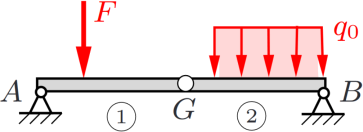
System 4:
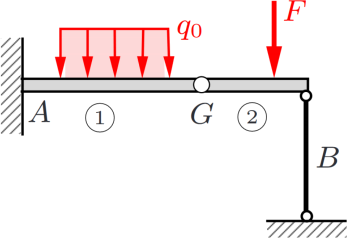
Section 2: Truss Analysis [20 marks]: This section focuses on truss analysis, wherein students will gain knowledge and understanding into identifying zero force members in different truss configurations. Specifically, students are tasked to:
1. Specify the support reactions through the corresponding static equilibrium equations (only write the equations, do not solve them) for each truss. Whenever member dimensions are not provided, feel free to annotate the corresponding scheme as you see fit.
2. Provide a detailed explanation through corresponding FBD’s justifying whether any of the members of the trusses are zero force members. If no zero force members exist, explain why this is the case. Through this section, students will deepen their understanding of truss configurations and the principles governing zero force members.
Truss 1 (F = 100 kN, l = 1 m):
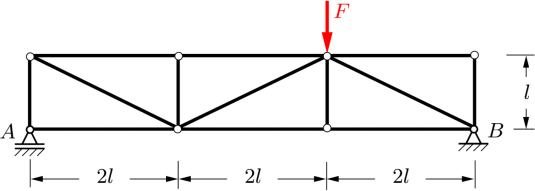
Truss 2 (F1 = 50 kN, F2 = 100 kN, F3 = 10 kN, a = 1 m):

Truss 3 (F1 = 100 kN, F2 = 0 kN):
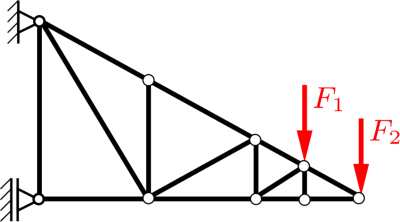
Truss 4 (F1 = 0 kN, F2 = 20 kN):
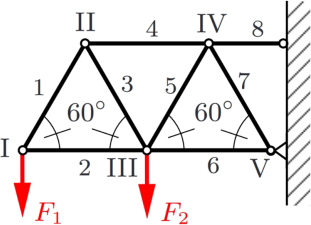
Section 3: Application of Method of Sections and Stress Strain relationships [40 marks]: Building upon the concepts introduced in Section 2, this section emphasizes the practical application of the method of sections in determining forces and consequently stresses and strains within truss members. Students are required to:
1. For Truss 2, apply the method of sections to determine the forces acting on 3 members of your choice within the selected truss. Students will apply theoretical knowledge to real-world scenarios, enhancing their problem-solving skills in structural analysis.
2. Calculate the normal stress at each of the three truss members that you selected, as well as the corresponding longitudinal (εx) and lateral (εy) strains.
3. Specify all the assumptions that you have made in order for the calculations in 3.2 to be valid for this specific material. As an example, provide a sketch of the relevant stress-strain curve showing all major areas of the diagram to support your answer. What would be the implications of your assumptions in the case that they were not valid?
Additional Information:
. Truss members are assumed to be made of solid circular cross-section steel bars, in the same way as demonstrated in the laboratory sessions.
. Nomimal diameter of steel bars: [d = 6 mm].
. Material Properties of Steel:
. Young's Modulus (E): [E = 210 GPa].
. Poisson's Ratio (ν): [0.28].
Assessment Criteria: Students will be assessed based on their ability to:
. Accurately identify support reactions and degrees of freedom in simple structural systems.
. Justify the identification of zero force members, or not, within trusses.
. Apply the method of sections effectively to determine forces and consequently stress and strains within truss members.
. Demonstrate understanding of material properties and their relevance to structural analysis.
. Present their solutions clearly and logically, demonstrating a systematic approach to problem- solving.
Marking Scheme:
|
Section 1 |
Free Body Diagrams |
12% (3% for each system) |
|
Types of Support |
8% (2% for each system) |
|
|
Degrees of Freedom |
12% (3% for each system) |
|
|
Static Determinacy |
8% (2% for each system) |
|
|
Section 2 |
|
|
|
Equilibrium Equations |
10% (2.5% for each system) |
|
|
Zero force members |
10% (2.5% for each system) |
|
|
Section 3 |
|
|
|
Method of Sections |
15% |
|
|
Calculation of Stress-Strain |
15% |
|
|
Assumptions & Stress-Strain Curve |
10% |
|
2024-04-10